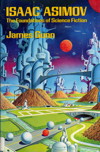“Isaac Asimov is a prodigy, and James Gunn the best possible choice to explicate his prodigiousness.” Frederik Pohl
“As readable as one of Asimov’s novels. Jim Gunn, as one of our foremost science fiction teachers and one of our ablest writers, is superbly qualified, and the book strikes me as the best sort of criticism.…An essential book for the student of science fiction, a delight for every serious fan, and a tempting dish for the casual reader.” Jack Williamson
One of science fiction’s most distinguished historians and critics here offers a rare insider’s view of the writer whose name has become synonoymous with science fiction today.
Drawing on his thirty-year friendship with Isaac Asimov, James Gunn shows how Asimov’s life was shaped by science fiction and how Asimov in turn shaped the field from the beginning of its Golden Age in 1939 to recent times. Gunn discusses the entire science fiction output of this prolific man of letters whose books total far beyond 200. He pays special attention to the Foundation stories and to the robot novels and stories.
In tracing the circumstances that have molded Asimov’s fiction, Gunn has devoted himself to what he calls “criticism in context,” examining Asimov’s work in light of the rise of science fiction magazines, the influence of his editors, and the writer’s own rational approach to the problems of the world—and of the universe.
This book is part of Oxford’s “Science-Fiction Writers” series. Having not read any of the other books in the series, it’s impossible for me to tell how much of an impact that makes on this one and makes it more difficult to evaluate the book on its own merits.
Gunn is an emeritus English professor at the University of Kansas and a science fiction writer himself. Here he offers a thorough analysis of all of Asimov’s science fiction through the early 1980’s.
Gunn’s fundamental thesis is that Asimov is a writer of rational science fiction, where thinking is the key to moving the story forward. One reason, he notes, why Asimov’s characters all seem somewhat alike is that they are (usually) men and women of action who reason their way through life. Even the villains are like that. They all react the same way, given the same premises. And the fiction embodies Asimov’s understanding of the scientific process, moving forward rationally.
Asimov’s science fiction is treated thematically: first the original Foundation “trilogy,” then the robot stories, and so on. All of Asimov’s science fiction published through the early 1980’s is covered. As of the time Gunn wrote, he was aware that a new Foundation novel was in the works, but naturally everything from Foundation’s Edge onwards isn’t covered. Works such as Fantastic Voyage and the lesser short fiction are given relatively short shrift, too, if any at all.
(One ironic point. Gunn’s analysis of The Caves of Steel and The Naked Sun lead him to suggest that they form a pretty complete whole as they stand, unlike the Foundation series which obviously could use a continuation. Asimov writing a new Foundation novel therefore makes sense to Gunn, but he notes that even though he knew that Asimov had intended to write a third robot novel, so far as Gunn was concerned that would be totally unnecessary. And of course Asimov went on to write two robot novels on top of the original pair, not just one.)
There’s really little to say. This is an excellent book. Gunn is insightful and interesting. I would heartily recommend it to any Asimov fan wishing to enhance their appreciation of the Good Doctor’s science fiction.
And the book carries on in its own right a time-honored science fiction tradition. The cover is a futuristic scene that has nothing to do with the contents. What more could one want?

